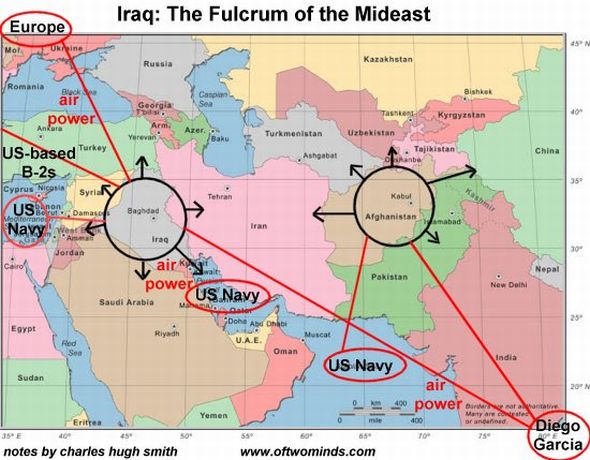“Those waiting for the U.S. and its dollar to collapse in a heap may find their own stability is more contingent (and fleeting) than they reckoned.” – C H Smith
Many observers (including myself) question the coherence of U.S. foreign policy in the Mideast: The Fatal Incoherence of the Bush/Obama Foreign Policy (June 18, 2014).
In my view, the incoherence stems from the intrinsic conflict between traditional (i.e. pre-1941) U.S. foreign policy (based on an uneasy marriage of non-intervention and the explicitly interventionist Monroe Doctrine) and the anti-imperialist values of the Founding Fathers, and the demands of maintaining global hegemony.
The other source of incoherence is the recent policy dominance of an intrinsically incoherent ideology of neo-Conservative Imperialism that is disconnected from both traditional non-interventionist U.S. values and the nuanced demands of maintaining global hegemony.
If we strip away these sources of incoherence, we’re left with the Deep State playing the Great Game of controlling the master resource, oil. A consistent narrative has little value in the playing of this game, other than for public-relations value, and those seeking a single narrative are inevitably perplexed by the multiple paradoxes and agendas of the Deep State.
This leads many observers to declare the Deep State’s game plan a disaster.
The important question is: which game plan? The incoherent one articulated by the president and his secretary of state? Or the one that nobody lays out because it would be the equivalent of showing everyone at the table all your cards?
The real game plan is flexible enough to tolerate multiple inconsistencies and paradoxes. The only goal is controlling the extraction and distribution of oil, and whatever serves this goal is in play. Switching sides, abandoning proxies, cutting deals with enemies–it’s all in play, all the time.
From this perspective, the game requires constant shifting of strategies in response to what’s working and what’s not working. If taking down Syria’s Assad with proxies didn’t work, then move on to Plan B or Plan C. If degrading Iran’s influence isn’t working, then move on to reproachment (privately at first, of course).
In other cases, the strategy is public but the working parts are not necessarily public. Financial sanctions are a good example; beneath the PR bravado and the propaganda war of sanctions and counter-sanctions, one side is getting hurt where it counts (i.e. in the personal fortunes of its Power Elites). If sanctions aren’t working, they’re replaced with Plan B or C. What Plan B or C might be is only visible between the lines.
In other cases, allies are reminded of who controls $40 trillion in financial resources and who controls $2 trillion.
The U.S. Deep State isn’t collecting “likes.” Everyone with a piece on the board has to deal with the U.S. in some fashion, whether they like it or not. Even the cliche of the enemy of my enemy is my friend doesn’t explicate the conflicting alliances the U.S. maintains.
One need only recall Nixon’s visit to China as evidence that all sorts of sacrosanct policies are fluidly jettisoned once the board changes and the Deep State sees the advantages of another arrangement.
In the case of Nixon and China, Nixon sought to rearrange the triangle of China, the U.S.S.R. and the U.S. to the advantage of the U.S. and China at the expense of the U.S.S.R.
In other cases, the U.S. game is served by disrupting competitors’ control of resources; if direct control isn’t possible with available assets, then indirect control via global finance is always an option. If that isn’t possible, then disrupting competitors’ control until other stresses bring them to their knees might work.
Everybody with a piece on the board is serving their own best interests. When cutting a deal with an implacable enemy serves your interests better than remaining enemies, that’s what you do–consistency doesn’t count. Friends, enemies, frenemies–labels, like consistency, don’t count.
I don’t know any more than any other marginalized, non-insider citizen. But just reading between the lines, I see the various Deep States playing 3-D chess and constantly adjusting strategies and game plans in response to other players’ moves. I would guess one U.S. Deep State strategy involves disrupting the alliance of Russia, Iran and Syria by whatever means are available, with the goal of securing working relationships of some sort with all three such that energy flows serve the U.S. Deep State agenda.
This doesn’t mean others’ interests aren’t being served; arrangements are only stable if they meet all the players’ core interests. Costs are raised or reduced, changing the incentives to deal, and at some point the benefits of changing the arrangement outweigh the costs.
Just glancing at this map, I’d guess it would serve both the U.S. and Iran to reach some sort of mutually beneficial arrangement.

Continue reading . . .
